In late 2011, I made a commitment to write a weekly blog with subject matter directly related to the heavier horse-drawn vehicles that helped build America. In addition to the dozens of feature length articles I've been fortunate to share, this week's blog marks my 150th post. As a way of highlighting that personal milestone, there is another reason the '150' number is special this year. 2014 marks the 150th Anniversary of the creation of Yosemite Park by Abraham Lincoln.
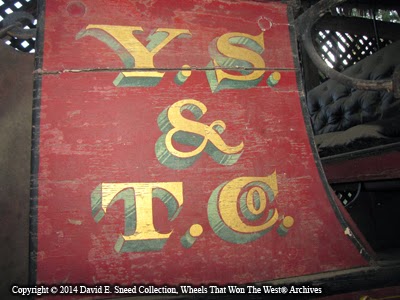 |
| The Yosemite Stage & Turnpike Company offered breathtaking tours of some of America's most beautiful scenery during California's early coaching days. |
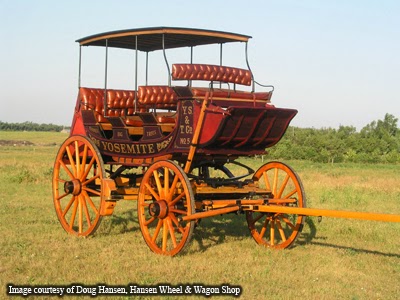 Doug Hansen and his team of professionals at Hansen Wheel & Wagon Shop completed this restoration of a vintage Yosemite coach several years ago.
Doug Hansen and his team of professionals at Hansen Wheel & Wagon Shop completed this restoration of a vintage Yosemite coach several years ago. The Park and the giant sequoia trees in Mariposa Grove have a long and storied history connected to coaching in the West. In 1877, thirteen years after President Abraham Lincoln ceded Yosemite to the state of California, the Yosemite Stage and Turnpike Company began offering stagecoach tours to Mariposa Grove, the largest stand of giant sequoias in what became Yosemite Nationa lPark in 1890. The sequoias are much the same today, but many of the open-sided touring coaches are gone. To get to the Big Trees by stage in the early days, drivers had to negotiate steep, narrow mountain roads with sheer drops and difficult switchbacks. On a few occasions, masked highwaymen disrupted these outings. In fact, during the first recorded robbery in 1883, passengers forked over an amazing $2,000 worth of cash and jewelry. Even without this extracurricular excitement, the tours often took all day.
With a continuing interest in these specially-designed vehicles as well as other stage and mountain wagons used in the late 1800s and early 1900s (and the fact that I've always wanted to see the giant redwoods up close), my wife and I made another trek out West a few months ago. As part of the venture, we made sure to include Mariposa Grove in our trip. From the legendary Half Dome granite rock to giant waterfalls, scenic roads, wildlife, and the big trees themselves, the area is incredibly beautiful and rich in American history.
Reaching the parking lot of the Grove well in advance of the tour buses, we were among the first to arrive. The morning air was cool but extremely comfortable for our 4-mile round trip hike into the impressive trees. Within sight of our parking spot we encountered one of the legendary trees often shown in the early coaching photos. It was the 'Fallen Monarch' which is believed to have met its demise more than 300 years ago. Climbing on this still-imposing piece is prohibited today but there are a number of photos from 19th century excursions showing horses, riders, coaches, and sight seers all atop this monstrous tree. The acids in the wood help prevent decay, so a number of the oldest toppled giants are still here to view.
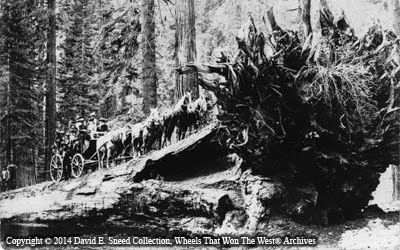
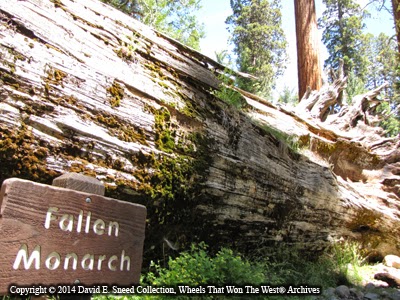
The photos above show the legendary 'Fallen Monarch' tree as it appeared in the late 1800's as well as today.
Moving up the well-marked trail, we began to hear the first rumblings of the tour vehicles. In some cases, these open air buses are traveling the same paths as the early horse drawn coaching parties did. Just over 2 miles up a zig-zagging mountain trail was a tree I've wanted to see for decades. It is the giant Tunnel Tree that has been the subject of so many photos over the years. Period images often show early coaches, mountain wagons, and automobiles being driven through it. As a bit of background to the Tunnel Tree's history, the Yosemite Stage and Turnpike Company hired two brothers in 1881 to cut an eight-foot-wide tunnel through the heart of the redwood, also known as the "Wawona" Tree. The brothers were paid $75 to create a passage more than 26 feet long and 10 feet tall. The majestic tree stood over 230 feet in height until it fell in 1969 under an especially heavy crown of snow.
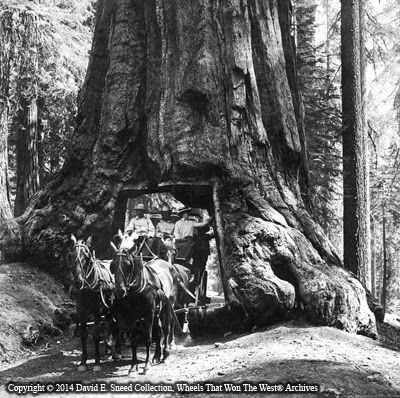 Perhaps the most famous tree in Mariposa Grove is the "Wawona" or Tunnel tree. It was a favorite place for 'drive-thru' photos for almost a century.
Perhaps the most famous tree in Mariposa Grove is the "Wawona" or Tunnel tree. It was a favorite place for 'drive-thru' photos for almost a century.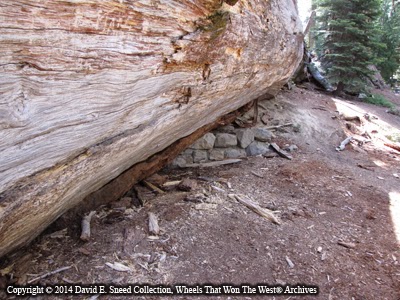
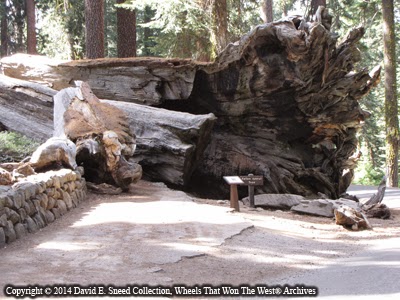
The two photos above show the legendary Wawona as it appears today. It lays where it fell in 1969. A close look reveals the old road beneath the giant.
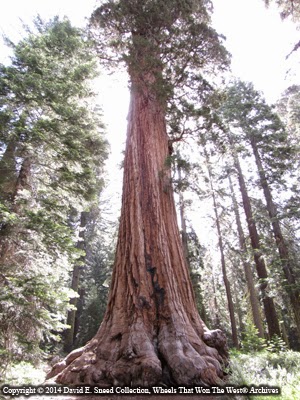
One of the many Giant Sequoia trees near the well-known Wawona Tunnel Tree.
While it's sad to see the fallen hulk on the ground, there is something especially grand about this tree that puts life in greater perspective. Prior to its fall, it was sometimes promoted as the "Oldest Living Thing." Believed to be as much as 2,300 years old when it fell, it stretched more than 230 feet into the air, was standing during the birth of Jesus Christ, and dwarfing the forest floor when Columbus stumbled upon the Americas. Billions of people lived their lives from start to end during the lifespan of this behemoth. It was a privilege to see while walking some of the same trails taken by early horse-drawn coaching parties.
Just a few miles from Mariposa Grove is the Pioneer Yosemite History Center. The facility contains a number of historic structures related to Yosemite as well as a significant collection of early western vehicles. We'll cover some of those special sets of wheels in an upcoming blog.
In the meantime, if you haven't yet signed up to receive NOTIFICATIONS each time we update our blogs, articles, and other sections of the 'Wheels' website, it's quick and easy. Just click on the SIGN UP link in the upper right of our website and leave us your email. If you haven't heard anything after a week or so, you might check your junk or spam folder to make sure your internet service provider isn't mislabeling the emails. Have a great week!!